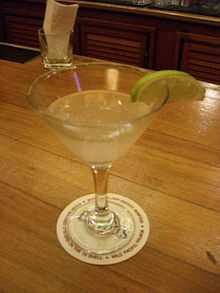Daiquiri
| IBA Official Cocktail | |
|---|---|
 | |
| Daiquiri garnished with lime | |
| Type | Cocktail |
| Primary alcohol by volume | |
| Served | Straight up; without ice |
| Standard garnish |
Half a lime slice |
| Standard drinkware | |
| IBA specified ingredients* |
|
| Preparation | Pour all ingredients into shaker with ice cubes. Shake well. Strain in chilled cocktail glass. |
Daiquiri (/ˈdækəriː/; Spanish: daiquirí [daikiˈɾi]) is a family of cocktails whose main ingredients are rum, citrus (typically lime juice), and sugar or other sweetener.
The daiquiri is one of the six basic drinks listed in David A. Embury's classic The Fine Art of Mixing Drinks. In the book, he also suggests some variations.
Origins
Daiquirí is also the name of a beach and an iron mine near Santiago, Cuba, and is a word of Taíno origin.[1] The drink was supposedly invented by an American mining engineer, named Jennings Cox, who was in Cuba at the time of the Spanish–American War. It is also possible that William A. Chanler, a US congressman who purchased the Santiago iron mines in 1902, introduced the daiquiri to clubs in New York in that year.[2]
Originally the drink was served in a tall glass packed with cracked ice. A teaspoon of sugar was poured over the ice and the juice of one or two limes was squeezed over the sugar. Two or three ounces of white rum completed the mixture. The glass was then frosted by stirring with a long-handled spoon. Later the daiquiri evolved to be mixed in a shaker with the same ingredients but with shaved ice. After a thorough shaking, it was poured into a chilled flute glass.
Consumption of the drink remained localized until 1909, when Rear Admiral Lucius W. Johnson, a U.S. Navy medical officer, tried Cox's drink. Johnson subsequently introduced it to the Army and Navy Club in Washington, D.C., and drinkers of the daiquiri increased over the space of a few decades. It was one of the favorite drinks of writer Ernest Hemingway and President John F. Kennedy.[3]
The drink became popular in the 1940s. Wartime rationing made whiskey, vodka, etc., hard to come by, yet because of Roosevelt's Good Neighbor policy rum was easily obtainable because the policy opened up trade and travel relations with Latin America, Cuba and the Caribbean. The Good Neighbor Policy, also known as The Pan-American program, helped make Latin America seem fashionable. Consequently, rum-based drinks (once frowned upon as being the domain of sailors and down-and-outs), also became fashionable, and the daiquiri saw a tremendous rise in popularity in the US.
The basic recipe for a daiquiri is also similar to the grog British sailors drank aboard ship from the 1740s onwards. By 1795 the Royal Navy daily grog ration contained rum, water, ¾ ounce of lemon or lime juice, and 2 ounces of sugar.[4] This was a common drink across the Caribbean, and as soon as ice became available this was included instead of the water.
Variations
- Daiquiri floridita – with maraschino liqueur, created by Constantino Ribalaigua Vert at El Floridita.
- Hemingway daiquiri – or papa doble – two and a half jiggers of white rum, juice of two limes and half a grapefruit, six drops of maraschino liqueur, without sugar, served frozen.[5]
- Banana daiquiri – regular daiquiri with a half a banana.[6]
- Strawberry daiquiri – regular with strawberry added.
Frozen daiquiri
A wide variety of alcoholic mixed drinks made with finely pulverized ice are often called frozen daiquirí. These drinks can also be combined and poured from a blender, eliminating the need for manual pulverization and producing a texture similar to a smoothie. On larger scales, such drinks are often commercially made in larger machines, and come in a wide variety of flavors made with various alcohol or liquors. Another way to create a frozen daiquiri (mostly fruit-flavored variants) is by using frozen limeade, providing the required texture, sweetness and sourness all at once.[7]
Variations on the frozen daiquirí.[8]
- the old rose daiquiri, which features strawberry syrup and rum along with two teaspoons of sugar and lime juice
- the daiquiri mulata featuring rum and coffee liqueur
See also
- List of cocktails
- Caipirinha – similar Brazilian cocktail
- Ti' Punch – similar French Caribbean cocktail
- Mojito – other popular and similar rum cocktail, adding lime, mint and soda
References
- Notes
- ↑ The United Confederation of Taíno People. "Taíno Dictionary" (in Spanish). Archived from the original on 2007-10-16. Retrieved 2007-10-18.
- ↑ Thomas, Lately. A pride of lions: the Astor orphans; the Chanler chronicle, W. Morrow, 1971; p. 168.
- ↑ Salvatore Calabrese (2002). Complete Home Bartender's Guide. Sterling Publishing Company, Inc. p. 76.
- ↑ Stephen R. Bown (2003). Scurvy. Thomas Dunne Books. p. 181. ISBN 0-312-31391-8.
- ↑ http://stockpress.de/2011/02/19/hemingway-trinkt-acht-daiquiris-in-el-floridita/ Hemingway's daiquiri - article in German
- ↑ http://www.iba-world.com/english/cocktails/bfd.php
- ↑ Frozen Strawberry Daiquiri Recipe
- ↑ Daiquiri Collection from Havana Club Rum
- Bibliography
External links
| Wikimedia Commons has media related to Daiquiri. |
| The Wikibook Bartending has a page on the topic of: Daiquiri |
- Digital Images regarding Jennings Cox including an original daiquirí recipe from the Carmen Puig Collection held by the Cuban Heritage Collection of the University of Miami Libraries
- A collection of Daiquiri Cocktail Recipes and variations
| ||||||||||||||||||||||||||||||||||||||
| ||||||||||||||